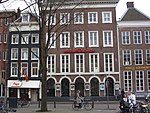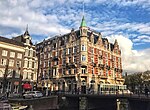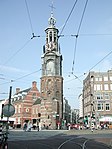Kloveniersdoelen, Amsterdam

The Kloveniersdoelen ("musketeers' shooting range") was a complex of buildings in Amsterdam which served as headquarters and shooting range for the local schutterij (civic guard). The companies of kloveniers were armed with an early type of musket known as an arquebus, known in Dutch as a bus, haakbus or klover (from the French couleuvrine), hence the name kloveniers. The Kloveniersdoelen was located at the corner of Nieuwe Doelenstraat and Kloveniersburgwal canal, both named after the former shooting range. The 19th-century Doelen Hotel now stands on the spot. Two kloveniers are depicted on the domed tower of the hotel, another reference to the history of this location. Rembrandt's painting The Night Watch was commissioned for the great hall of the Kloveniersdoelen.
Excerpt from the Wikipedia article Kloveniersdoelen, Amsterdam (License: CC BY-SA 3.0, Authors, Images).Kloveniersdoelen, Amsterdam
Nieuwe Doelenstraat, Amsterdam Centrum
Geographical coordinates (GPS) Address Nearby Places Show on map
Geographical coordinates (GPS)
| Latitude | Longitude |
|---|---|
| N 52.367777777778 ° | E 4.8955555555556 ° |
Address
Universiteitstheater
Nieuwe Doelenstraat
1012 CP Amsterdam, Centrum
North Holland, Netherlands
Open on Google Maps










